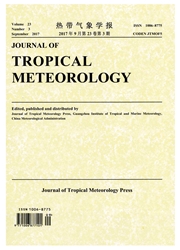

 中文摘要:
中文摘要:
在 1960-2003 的时期期间在中国和 NCEP/NCAR 每月的分析数据基于 743 个车站的每日的降雨数据集,在在在南部的半球的中国和大气的循环的南方的异常极端降水(EP ) 之间的关系被分析。在在粗糙表面海和新西兰上的海水平压力和 geopotential 高度异例的相反的变化的现象被定义为 RN,并且描述这现象的索引被表示为 RNI。结果证明 RN 有 barotropic 结构,在 5 月的 RNI 是仔细在中国(SCEP ) 和东方亚洲夏天季风(EASM ) 的南方与 6 月 EP 有关总计。在在每水平和 6 月 SCEP 的 5 月 RNI 之间的积极关联是重要的,并且在 RNI 之间的相关同时的关联和 6 月 SCEP 也是积极的,建议 SCEP 上的 RN 的潜在的影响从 5 月坚持到 6 月。因此,在 5 月的 RN 能为 6 月 SCEP 作为预兆的因素之一被拿。而且, RN 由影响 6 月 SCEP 的一可能的物理机制是 barotropic 从南部的半球发出到西方的诺思太平洋的南方的 teleconnection。
 英文摘要:
英文摘要:
Based on the daily rainfall datasets of 743 stations in China and the NCEP/NCAR monthly reanalysis data during the period of 1960- 2003, the relationship between the anomalous extreme precipitation (EP) in the south of China and atmospheric circulation in the Southern Hemisphere is analyzed. The phenomenon of opposite changes in the sea level pressure and geopotential height anomalies over the Ross Sea and New Zealand is defined as RN, and the index which describes this phenomenon is expressed as RNI. The results show that the RN has barotropic structure and the RNI in May is closely related to the June EP amount in the south of China (SCEP) and the East Asian summer monsoon (EASM). The positive correlations between the May RNI at each level and the June SCEP are significant, and the related simultaneous correlations between the RNI and the June SCEP are also positive, suggesting that the potential impact of RN on the SCEP persists from May to June. Therefore, RN in May can be taken as one of the predictive factors for the June SCEP. Furthermore, one possible physical mechanism by which the RN affects the June SCEP is a barotropic meridional teleconnection emanating from the Southern Hemisphere to the western North Pacific.
 同期刊论文项目
同期刊论文项目
 同项目期刊论文
同项目期刊论文
 THE RELATIONSHIP BETWEEN EXTREME PRECIPITATION ANOMALY IN SOUTH OF CHINA AND ATMOSPHERIC CIRCULATION
THE RELATIONSHIP BETWEEN EXTREME PRECIPITATION ANOMALY IN SOUTH OF CHINA AND ATMOSPHERIC CIRCULATION SEASONAL PERSISTENCE OF THE WEST PACIFIC SUBTROPICAL HIGH AND ITS RELATIONSHIP WITH THE SURFACE HEAT
SEASONAL PERSISTENCE OF THE WEST PACIFIC SUBTROPICAL HIGH AND ITS RELATIONSHIP WITH THE SURFACE HEAT The relationship of Land-Ocean thermal anomaly difference with Mei-yu and South China Sea summer mon
The relationship of Land-Ocean thermal anomaly difference with Mei-yu and South China Sea summer mon Impacts of land surface and sea surface temperatures on the onset data of the South China Sea summer
Impacts of land surface and sea surface temperatures on the onset data of the South China Sea summer The vertical structures of atmospheric temperature anomalies associated with El Nio simulated by the
The vertical structures of atmospheric temperature anomalies associated with El Nio simulated by the Simulation of the East Asian Summer Monsoon during the Last Millennium with the MPI Earth System Mod
Simulation of the East Asian Summer Monsoon during the Last Millennium with the MPI Earth System Mod Sensitivity of a regional ocean-atmosphere coupled model to convection parameterization over western
Sensitivity of a regional ocean-atmosphere coupled model to convection parameterization over western Two modes of the Silk Road pattern and their inter-annual variability simulated by LASG/IAP SAMIL2.0
Two modes of the Silk Road pattern and their inter-annual variability simulated by LASG/IAP SAMIL2.0 Variation of surface temperature during the last millennium in a simulation with the FGOALS_gl clima
Variation of surface temperature during the last millennium in a simulation with the FGOALS_gl clima Near Future (2016-2040) summer precipitation changes over China under RCP8.5 emission scenario proje
Near Future (2016-2040) summer precipitation changes over China under RCP8.5 emission scenario proje Two interannual variability modes of the Northwestern Pacific Subtropical Anticyclone in boreal summ
Two interannual variability modes of the Northwestern Pacific Subtropical Anticyclone in boreal summ Intensified eastward and northward propagation of tropical intraseasonal oscillation over equatorial
Intensified eastward and northward propagation of tropical intraseasonal oscillation over equatorial Historical Evolutions of Global and Regional Surface Air Temperature Simulated by FGOALS-s2 and FGOA
Historical Evolutions of Global and Regional Surface Air Temperature Simulated by FGOALS-s2 and FGOA El Nino-Southern Oscillation-related principal interannual variability modes of early and late summe
El Nino-Southern Oscillation-related principal interannual variability modes of early and late summe A comparison of the Medieval Warm Period, Little Ice Age and 20th century warming simulated by the F
A comparison of the Medieval Warm Period, Little Ice Age and 20th century warming simulated by the F Forced response of atmospheric oscillations during the last millennium simulated by a climate system
Forced response of atmospheric oscillations during the last millennium simulated by a climate system Simulated analysis of summer climate on centennial time scale in eastern China during the last mille
Simulated analysis of summer climate on centennial time scale in eastern China during the last mille Another Look at Interannual-to-Interdecadal Variations of the East Asian Winter Monsoon: The Norther
Another Look at Interannual-to-Interdecadal Variations of the East Asian Winter Monsoon: The Norther Forced response of the East Asian summer rainfall over the past millennium: results from a coupled m
Forced response of the East Asian summer rainfall over the past millennium: results from a coupled m Interdecadal variations of the western Pacific subtropical high and surface heat flux over East Asia
Interdecadal variations of the western Pacific subtropical high and surface heat flux over East Asia 期刊信息
期刊信息
